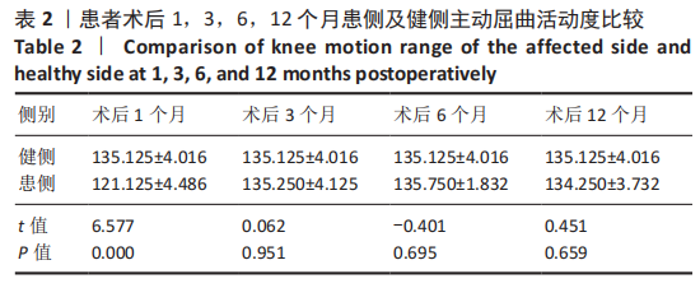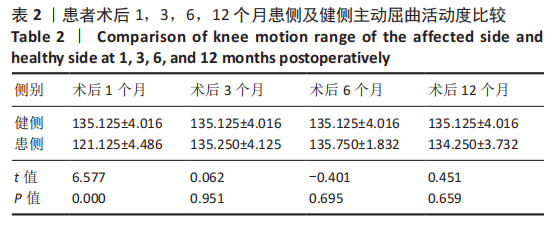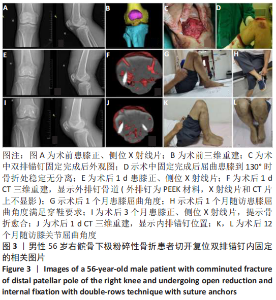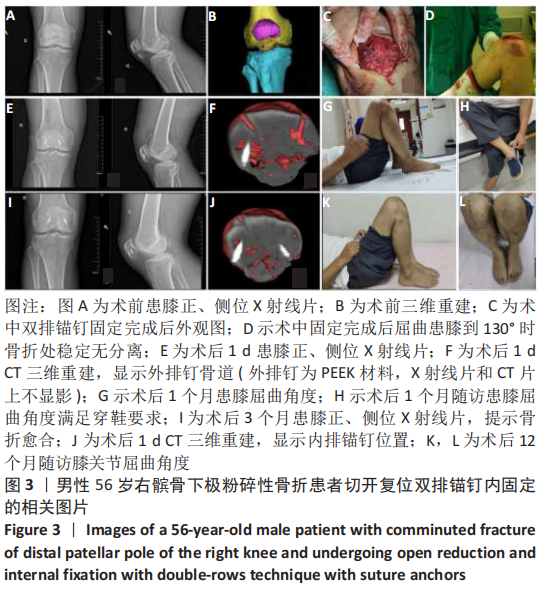[1] BOSTRÖM A. Fracture of the patella. A study of 422 patellar fractures. Acta Orthopaedica Scandinavica Supplementum. 1972;143(S143):1-80.
[2] NEUMANN HS, WINCKLER S, STROBEL M. Long-term results of surgical management of patellar fractures. Der Unfallchirurg. 1993;96(6):305.
[3] CANALE ST, BEATY JH. Campbells Operative Orthopedics. 11th ed. St Louis: Mosby, 2008: 3161-3169.
[4] ANDREWS JR, HUGHSTON JC. Treatment of patellar fractures by partial patellectomy. South Med J. 1977;70(7):809-813.
[5] BÖSTMAN O, KIVILUOTO O, NIRHAMO J. Comminuted displaced fractures of the patella. Injury. 1981;13(3):196-202.
[6] ANAND A, KUMAR M, KODIKAL G. Role of suture anchors in management of fractures of inferior pole of patella. Indian J Orthop. 2010;44(3):333-335.
[7] 杨怀阔,马占忠,薛磊,等.带线锚钉治疗髌骨粉碎性骨折13例[J]. 中国中医骨伤科杂志,2018,26(1):53-55.
[8] KADAR A, SHERMAN H, DREXLER M, et al. Anchor suture fixation of distal pole fractures of patella: twenty seven cases and comparison to partial patellectomy. Int Orthop. 2016;40(1):149-154.
[9] 陈羽,王树强,房雷,等. 双滑轮技术结合”8”字张力带治疗髌骨下极粉碎性骨折[J]. 第二军医大学学报,2019,40(10):1135-1138.
[10] ROOS EM, ROOS HP, LOHMANDER LS, et al. Knee Injury and Osteoarthritis Outcome Score (KOOS)--development of a self-administered outcome measure. J Orthop Sports Phys Ther. 1998;28(2):88.
[11] 吴卫东,朱立帆,曾金才,等.钢丝环扎+双重髌前“8”字张力带治疗髌骨下极粉碎骨折[J].中国矫形外科杂志,2017,25(22):2103-2105.
[12] 林学义,林煜,李平,等.改良张力带钢丝联合可吸收带线锚钉内固定治疗髌骨下极撕脱骨折疗效观察[J].中国骨与关节损伤杂志,2020,35(8):833-835.
[13] 高翔,刘辉,郑吉湘,等.钢丝垂直间断缝合结合带线锚钉固定治疗髌骨下极粉碎性骨折[J].中华创伤骨科杂志,2017,19(2):169-172.
[14] 宋大卫,张成栋,于丕学,等.Krachow法缝合联合钢丝垂直间断固定治疗髌骨下极粉碎性骨折[J].中国临床研究,2020,33(9):1221-1223.
[15] 张鹰,杨宇,李凡,等.Cable-pin系统与克氏针张力带治疗髌骨骨折的疗效比较[J]. 浙江医学,2016,38(14):1184-1187.
[16] MATEJCI A, PULJIZ Z, ELABJER E, et al. Multifragment fracture of the patellar apex: Basket plate osteosynthesis compared with partial patellectomy. Arch Orthop Trauma Surg. 2008; 128(4):403-408.
[17] 史凤之,孙国荣,吴成如,等.聚髌器治疗髌骨下极撕脱性骨折对患者术后膝关节功能的改善效果[J].解放军预防医学杂志,2018,36(6):729-731.
[18] 王培召, 韩旭, 王啸,等. 不可吸收缝合线捆扎结合髌骨爪固定治疗髌骨下极骨折疗效观察[J]. 中国修复重建外科杂志,2020,34(10):1243-1247.
[19] KRKOVIC M, BOMBAC D, BALAZIC M, et al. Modified pre-curved patellar basket plate, reconstruction of the proper length and position of the patellar ligamentigamentamental k,analysis. Knee. 2007;14(3):188-193.
[20] 耿震,林永杰,王国伟,等. 带线锚钉结合髌骨爪治疗髌骨下极骨折[J]. 中国矫形外科杂志,2019,27(14):1330-1332.
[21] 林学义,林煜,李平,等. 改良张力带钢丝联合可吸收带线锚钉内固定治疗髌骨下极撕脱骨折疗效观察[J]. 中国骨与关节损伤杂志,2020,8(35): 833-835.
[22] 赵孝凯,张昊,周大鹏,等. 带线锚钉结合皮质骨螺钉治疗髌骨下极骨折的效果分析[J]. 中国临床实用医学,2019,10(6):5-8.
[23] 张如意,唐佩福,张立海,等.锚钉技术治疗髌骨下极撕脱骨折的疗效分析[J].中国矫形外科杂志,2017,25(8):700-703.
[24] 徐国浩,宁显宗.单枚带线锚钉内固定治疗髌骨下极粉碎性骨折[J].中国骨与关节损伤杂志,2020,35(6):619-620.
[25] 马武秀, 辛庆峰, 郑国海,等. 双排可吸收锚钉桥式缝合固定后交叉韧带止点骨折疗效分析[J]. 实用骨科杂志,2020,26(2):86-89.
[26] DENARD PJ, BURKHART SS. Double-Row Suture-Bridging Arthroscopic Rotator Cuff Repair. Oper Tech Orthop. 2013;23(2):84-90.
[27] YAMAGUCHI S, ENDO J, YAMAMOTO Y, et al. Double-Row Bridging Suture Fixation Augmented With Double Krackow Suture for the Repair of Avulsion of the Ossified Achilles Tendon: A Technical Tip. Foot Ankle Int. 2015;36(7):849-852.
[28] 卞为伟, 唐晓波, 王健,等. 关节镜下双排锚钉缝线桥固定技术与切开复位钢板内固定术治疗单纯肱骨大结节骨折的疗效比较[J]. 中华创伤骨科杂志,2020,22(7):604-609.
[29] 刘刚,张磊,汪国友,等. 全关节镜下双排缝合锚钉修复肱骨大结节MutchⅠ型骨折的临床分析[J].中国组织工程研究,2017,21(19):3005-3010.
[30] DOUGLASS NP, BEHN AW, SAFRAN MR. Cyclic and Load to Failure Properties of All-Suture Anchors in Synthetic Acetabular and Glenoid Cancellous Bone. Arthrosc J Arthrosc Relat Surg. 2017;33(5):977-985.
(责任编辑:GD,ZN,ZH)
|





